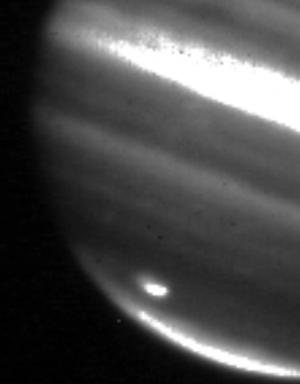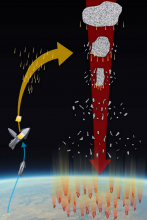Jupiter, the largest planet in the solar system, periodically gets walloped by comets or asteroids, producing massive explosions. The most recent was seen in late 2023. This image, from 2009, shows the aftermatth of an impact as a bright white spot near the bottom. Recorded in infrared light, it shows the heat generated by the blast. By pulling in these bodies, Jupiter may help protect Earth and the other inner planets from similar collisions. [NASA/JPL/Infrared Telescope Facility]
You are here
Moon and Jupiter
Jupiter has been described as the vacuum cleaner of the solar system. The planet’s powerful gravity sucks in comets and asteroids. They’re destroyed as they slam into Jupiter’s atmosphere. That keeps those objects from possibly threatening Earth and the other inner planets.
Scientists have seen several of these impacts. They’ve seen some of them directly, as bright flashes of light. For others, they’ve seen the aftermath — big, dark scars in Jupiter’s atmosphere.
One of the most recent impacts came last summer. Amateur astronomers in Asia saw a bright flash of light on August 28th. One of them even recorded the flash on video. It lasted several seconds.
An early analysis said the flash was similar to another one a couple of years earlier. It probably was the equivalent of a blast on Earth in 1908. Known as the Tunguska event, it occurred when an asteroid or comet exploded in the upper atmosphere. It leveled hundreds of square miles of Siberian forest.
The biggest impact yet seen on Jupiter took place in 1994. Jupiter’s gravity pulled apart a large comet. It then pulled in the remains, which created about a dozen big blasts. The scars from those impacts were visible for months.
Jupiter keeps company with the Moon the next couple of nights. It looks like a brilliant star. It’s to the left or upper left of the Moon tonight, and closer below the Moon tomorrow night.
Script by Damond Benningfield
Get Premium Audio
Listen to today's episode of StarDate on the web the same day it airs in high-quality streaming audio without any extra ads or announcements. Choose a $8 one-month pass, or listen every day for a year for just $30.






